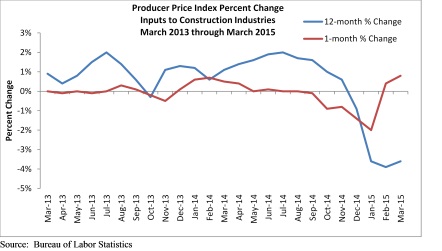Results from the Bureau of Labor Statistics showed that prices for construction materials rose 0.8% in March. According to Associated Builders and Contractors, Inc., it was the largest monthly increase in more than two years.
Prices for construction materials have risen for two straight months after falling for the previous six.
Although prices are up on a monthly basis, statistics showed that input prices are down 3.6% on a year-over-year basis, the fourth consecutive month this has occurred. The steady decline in input prices is the longest streak since 2009 as crude petroleum prices fell 4% in March and are down eight of the last nine months.
"Though U.S. nonresidential and residential segments continue to expand, global construction volumes remain suppressed by widespread weakness in Asia, Europe, and Latin America," said ABC Chief Economist Anirban Basu. "With the U.S. dollar likely to get stronger over the next few months as domestic interest rates begin to rise, there is little likelihood of significant increases in construction input prices over the next six to nine months. Overall producer prices managed to increase 0.5% on a monthly basis, the first increase since June 2014. This reading serves to increase the likelihood that the Federal Reserve will begin to increase short-term interest rates later this year."

There were only two key material categories that saw an increase in construction prices in March: fabricated strucutal metal produce prices (0.4%) and natural gas prices (1.5%).
While these two inputs rose, others fell:
- Prices for plumbing fixtures dropped 0.3% in March but remain up 2.5% year-over-year.
- The price of prepared asphalt, tar roofing, and siding dipped 0.4% in March.
- Iron and steel prices dropped 2.5% in March and are down 11.5% year-over-year.
- Prices for steel mill products slipped 1.9% in March and are down 4.8% on a yearly basis.
- Concrete products prices were flat but up 4.1% year-over-year.
- Crudge petroleum prices dropped 4% in March and are down 55% from the same time last year.
- Crude energy material costs decreased 1.4% in March and are down 43.7% from the previous year.
- Softwood lumed prices fell 4.1% and are down 7.4% year-over-year.
- Prices for nonferrous wire and cable were flat in March and rose 2.5% on a yearly basis.
To read the entire report, click here.
Related Stories
| Dec 14, 2011
Tyler Junior College and Sika Sarnafil team up to save energy
Tyler Junior College wanted a roofing system that wouldn’t need any attention for a long time.
| Dec 13, 2011
Lutron’s Commercial Experience Center awarded LEED Gold
LEED certification of the Lutron facility was based on a number of green design and construction features that positively impact the project itself and the broader community. These features include: optimization of energy performance through the use of lighting power, lighting controls and HVAC, plus the use of daylight.
| Dec 12, 2011
AIA Chicago announces Skidmore, Owings & Merrill as 2011 Firm of the Year
SOM has been a leader in the research and development of specialized technologies, new processes and innovative ideas, many of which have had a palpable and lasting impact on the design profession and the physical environment.
| Dec 12, 2011
Mojo Stumer takes top honors at AIA Long Island Design Awards
Firm's TriBeCa Loft wins "Archi" for interior design.
| Dec 10, 2011
10 Great Solutions
The editors of Building Design+Construction present 10 “Great Solutions” that highlight innovative technology and products that can be used to address some of the many problems Building Teams face in their day-to-day work. Readers are encouraged to submit entries for Great Solutions; if we use yours, you’ll receive a $25 gift certificate. Look for more Great Solutions in 2012 at: www.bdcnetwork.com/greatsolutions/2012.
| Dec 10, 2011
Energy performance starts at the building envelope
Rainscreen system installed at the west building expansion of the University of Arizona’s Meinel Optical Sciences Center in Tucson, with its folded glass wall and copper-paneled, breathable cladding over precast concrete.
| Dec 10, 2011
Turning Balconies Outside In
Operable glass balcony glazing systems provide solution to increase usable space in residential and commercial structures.
| Dec 10, 2011
BIM tools to make your project easier to manage
Two innovations—program manager Gafcon’s SharePoint360 project management platform and a new BIM “wall creator” add-on developed by ClarkDietrich Building Systems for use with the Revit BIM platform and construction consultant—show how fabricators and owner’s reps are stepping in to fill the gaps between construction and design that can typically be exposed by working with a 3D model.
| Dec 7, 2011
NSF International qualifies first wallcoverings distributor to the New American National Standard for Sustainable Wallcoverings
TRI-KES demonstrates leadership in environmental stewardship as the first distributor to earn qualification.
| Dec 7, 2011
Autodesk agrees to acquire Horizontal Systems
Acquisition extends and accelerates cloud-based BIM solutions for collaboration, data, and lifecycle management.

















